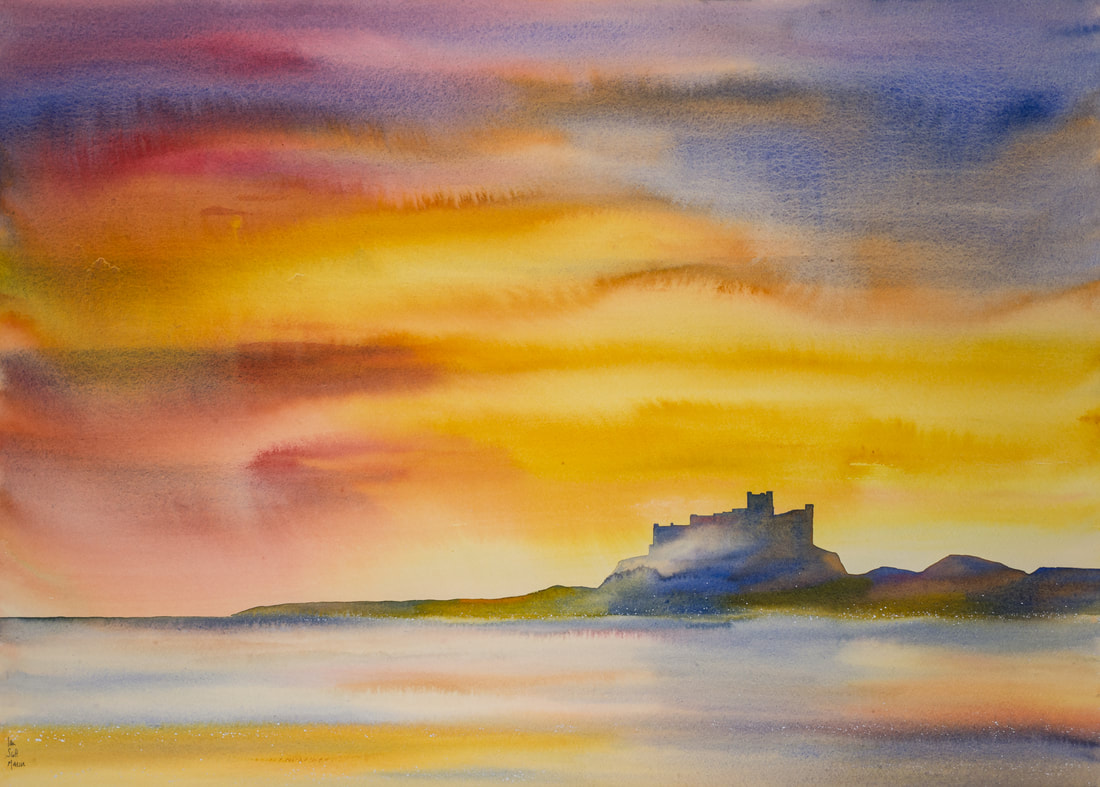Bamburgh by Ian Scott Massie
Original Watercolour
28" x 36" Mounted size - 22" x 30" Image size
SOLD
28" x 36" Mounted size - 22" x 30" Image size
SOLD
BAMBURGH CASTLE
Looking southward, as the train approaches Berwick, the iconic silhouette of Bamburgh Castle graces the horizon. Few buildings conjure up the romance of legends so well and, unsurprisingly, this is another well-used filming location. It is also a favourite subject of mine. The castle is set high on a rocky outcrop above the dunes, the beach and shining sands. People have lived on this rock since the Celts of Bernicia founded their realm in the 5th century. Then came the Saxons, until their fort was destroyed by the Vikings in 993.
The Earls of Northumberland have a long history of making trouble for the monarchs of England and Robert de Mowbray was no exception. In 1095, he refused to appear before William II to answer charges, following his plundering of four Norwegian ships. As always, the common people bore the brunt of the violence as the king stamped on the defenders of Tynemouth, Newcastle and Morpeth on his way to chastise Robert.
When he arrived at Bamburgh, the king had built a castle of wood which he named Malvoisin (Evil Neighbour) from which to administer his court, conduct the siege and frighten the defenders. His soldiers were apparently encouraged to shout insults to the besieged castle. By a stroke of luck, William managed to capture the Earl, but had reckoned without his chief supporter, Robert’s young wife, Matilda de Aquila. She had no intention of surrendering, and the siege continued. It was only when William threatened to blind the Earl that she agreed to give up.
There is something Arthurian about Bamburgh, and it’s been suggested as the imagined setting of Lancelot’s castle of Joyous Gard, to which he brought his lover Guinevere, having saved her from a death sentence. In the later chapters of the great legend Lancelot’s body is brought to Joyous Gard for burial. It seems fitting that the most beautiful and skilful knight of medieval chivalry should rest in such a beautiful place.
The Earls of Northumberland have a long history of making trouble for the monarchs of England and Robert de Mowbray was no exception. In 1095, he refused to appear before William II to answer charges, following his plundering of four Norwegian ships. As always, the common people bore the brunt of the violence as the king stamped on the defenders of Tynemouth, Newcastle and Morpeth on his way to chastise Robert.
When he arrived at Bamburgh, the king had built a castle of wood which he named Malvoisin (Evil Neighbour) from which to administer his court, conduct the siege and frighten the defenders. His soldiers were apparently encouraged to shout insults to the besieged castle. By a stroke of luck, William managed to capture the Earl, but had reckoned without his chief supporter, Robert’s young wife, Matilda de Aquila. She had no intention of surrendering, and the siege continued. It was only when William threatened to blind the Earl that she agreed to give up.
There is something Arthurian about Bamburgh, and it’s been suggested as the imagined setting of Lancelot’s castle of Joyous Gard, to which he brought his lover Guinevere, having saved her from a death sentence. In the later chapters of the great legend Lancelot’s body is brought to Joyous Gard for burial. It seems fitting that the most beautiful and skilful knight of medieval chivalry should rest in such a beautiful place.





